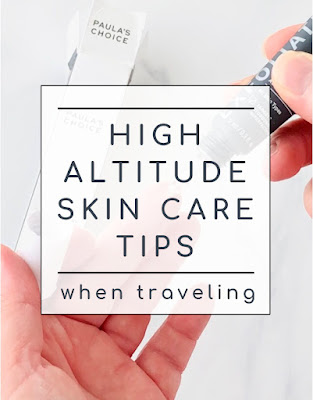Having recently traveled from Seattle (elevation 100') to the intermountain west (elevation 4400'), I can tell you that the drastic change in altitude absolutely affected my skin.
I learned that because the sun's rays have less atmosphere to travel thru, and due to the thinning atmosphere, UV rays can be much more intense at high altitudes than they are at sea level. [- Rocky Mountain Urgent Care and Family Medicine]
Here's how to protect your skin when traveling to higher altitudes.
5 High Altitude Skin Care Tips when traveling
1. Watch your "Actives"
By "actives", I mean skin care products that contain active ingredients.
Some actives can be more reactive to the skin than others, like retinols, BHA's & AHA's (i.e., Beta & Alpha Hydroxy Acids), vitamin C, etc., while other active ingredients are more easy on the skin like hyaluronic acid, niacinamide, and ceramides.
I learned the hard way that skin care products containing more reactive active ingredients can be the most difficult to use when going from a lower elevation to a higher one.
My sensitive skin is always more prone to irritation when I travel, so knowing this, I decided NOT to use my Olay retinol cream during our stay (which turned out to be the right choice for me).
My BHA serum, however, was another story. I use it as a spot treatment on my nose for sebaceous hyperplasia bumps and unfortunately after a couple of nights in our new high altitude climate, it turned my nose bright red, so I stopped using it.
2. Apply Sunscreen Daily
Wearing Sunscreen every day is a must for protecting your skin against the effects of aging and prevention of skin cancer. While traveling to higher altitudes, you need to make it a priority whether rain, sun, or snow. Don't be fooled by the weather. UV rays get through the clouds and bounce around off bright surfaces (like snow). Bottom line, just be diligent about wearing your sunscreen or you'll have other skin problems to deal with (like burns).
3. Drink More Water
When going from a lower altitude to a higher one, your body and skin will go through changes.
Arriving at a higher elevation than you're used to living in, can make your more tired and breathless while doing normal activities because your body doesn't have as many red blood cells as it needs to operate at the same level of activity in this new place. The longer you stay in the higher altitude, the more red blood cells your body will generate to help adapt to your new environment.
Because of this process, your body is exerting more energy and requires more water than you think it does.
Your skin will also be prone to dryness and while drinking water can help that, you'll also need skin care products to help seal in moisture (see tip # 4).
4. Use a Thicker Moisturizer
I use a thicker moisturizer year-round in Seattle, where the temperatures don't usually get too extreme one way or the other.
Traveling to a higher altitude area, and/or one that is drier, or colder, your skin will probably need a thicker moisturizer to lock in the moisture. This doesn't just mean drinking more water, which is helpful for all cells in your body (including those that support your skin), it also means locking in the moisture you have ON your skin.
Right out of the shower when your skin is still moist, slather yourself (and yes, even your face) with my favorite CeraVe Moisturizing Cream to lock in all the moisture you can get. CeraVe has the good, gentle actives you need for your skin health like hyaluronic acid (that draws water into the skin), and ceramides (the building blocks of a healthy skin barrier).
5. Listen to your skin
You may be either tempted to be lax about your skin care routine because you're traveling or think you can still use all the same products in the same way you do at home.
Different environments, climates, conditions and high altitude, can affect your skin and if you don't believe me, your skin will show you.
I was reminded because of how my skin behaved, (redness, irritation and rosacea flares) that I needed to stop reactive actives when I travel to high altitudes, and be better about being timely with my skin care routine in the morning, instead of waiting for hours to wash my face after hanging out in my pj's.
Your skin will show you what it needs.
When my skin started acting up, I gently returned to my normal skin care routine products and schedule and my skin is slowly coming back around.
+
If your skin does become reactive, here's my favorite simple skin care routine that can bring your skin back to peace and calm:
(*some amazon affiliate links have been added for your convenience. I earn a small commission on products purchased through our links. Thank you for your support.)
Simple High Altitude Skin Care Routine to Calm Skin
Facial Washing:
Soft flannel Fairface Washcloths
and
Facial and Body Moisturizing:
Daytime Facial Sunscreen (can also be used on your body)
Are there other skin care tips that help you in high altitudes? Leave us a comment below!
This post is brought to you by Shannon Sorensen, the founder of Fairface Washcloths, the best soft flannel washcloths and face cloths for sensitive skin!


No comments:
Post a Comment